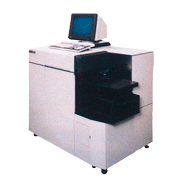The OCR60 handwritten kanji character reader was the first terminal OCR to read documents with mixtures of handwritten Kanji and katakana characters at high speeds and with high accuracy. OCR60 terminals were installed to support customer-service operations as part of the Ministry of Transport’s Motor-car Total Information Advanced System (MOTAS), which started operation in 1988.
The terminal OCRs for alphabets, numerals, and katakana characters that first arrived in the early 1980s had become more compact and cheaper with advances in LSI technology and were well suited for data entry of various administrative forms and sales slips. But in the area of Japanese language entry needs, there was a strong demand for handling names, addresses, and other data fields in Kanji characters. At the same time, notable advances were being made in Kanji recognition technology. The OCR60 arrived at this time as an effective means of entering handwritten Kanji characters for Japanese language processing.
- The main features of the OCR60 were as follows:
- Able to read handwritten Kanji characters, alphanumerals and katakana characters with high accuracy: It was able to set up separate reading fields with the implementation of Feature Concentration Method which had a track record with alphanumerals and katakana characters, for non-Kanji characters in addition to a newly developed Stroke Structure Concentration Method for handwritten Kanji characters.
- Rich set of readable characters: The OCR60 could read approximately 3,200 handwritten Kanji characters (JIS Level 1), hiragana characters, alpha-numeric characters, katakana characters, and symbols as well as many alphanumerals, katakana characters, and symbols in OCR-B and K (print) fonts.
- Fast reading speeds: The effective kanji character reading speed was 20 characters a second, which was about 30 times faster than a human typist.
- Enhanced knowledge processes: The OCR60 was equipped with knowledge processes using a word dictionary for place names, personal names, and company names, a furigana dictionary, and a Japanese grammar dictionary for ordinary sentences. Custom user word dictionaries could be read and stored in the OCR60.
- Handy processes for correcting input data: Images of characters that could not be recognized were shown on the display, and the operator was able to immediately correct or add the character using the OCR’s built-in word-processing functions.
| Parameter | Specification | |
|---|---|---|
| Recognition method | Kanji characters: Stroke Structure Concentration Method Non-kanji characters: Feature Concentration Method |
|
| Read speeds | Character reading (effective speed) | Kanji characters: 50 characters per second (20 characters per second) Non-kanji characters: 100 characters per second (35 characters per second) |
| Form processing | Kanji characters: 7 sheets per minute Non-kanji characters: 11 sheets per minute (reading 10 lines of 20 characters each per A4 form) |
|
| Readable characters | Handwritten | Kanji characters: 2,965 (JIS Level 1), hiragana, ANKS |
| Printed | Katakana characters, alpha-numeric characters, and symbols (OCR-B, K size I) | |
| Entry boxes and character pitches | Handwritten | Kanji characters: 10 x 10 mm boxes, 11 mm pitch Non-kanji characters: 7 x 5 mm boxes, 6 mm pitch |
| Printed | 10 characters per inch pitch | |
| Forms | Sizes and thicknesses | From 100 x 100 mm to 364 x 297 mm (l x w), ream weight from 55 to 110 kg |
| Paper quality | OCR paper, fine paper (brand specification) | |
| Paper feed | Continuous (automatic) / One-sheet (manual insertion) | |
| Form capacities | Hopper | 200 sheets (elevator format) |
| Stackers | Accept: 200 sheets Reject: 100 sheets |
|
| Format definitions for forms | Able to store up to 255 format definitions on the internal hard drive | |
| Sequence number printing | Six-digit numbering (printed on reverse side of the form, print location selectable)) |
|
| Knowledge process | Word dictionary | Surnames: about 5,000 Personal names: about 5,000 Place names: about 4,000 ※Users can add custom words to the dictionary |
| Furigana dictionary | Surnames: about 10,000 Personal names: about 10,000 |
|
| Standard word dictionary | About 65,000 words | |
| External memory devices | Five-inch floppy disk drive, 40 MB hard disk drive | |
| I/O interfaces | RS-232C and HDLC loop | |
| Other functions | Data check functions: basic arithmetic operations, data length checks, etc. Data processing functions: fixed data verifications, zero filling, etc. |
|
| Dimensions and weight | Main unit:90 x 70 x 100 cm (w x d x h) Display:38 x 37 x 41 cm (w x d x h) Keyboard:51 x 25 x 6 cm (w x d x h) Total weight approximately 256 kg |
|
| Power supply | 100±10 V, approximately 2.8 KVA | |


